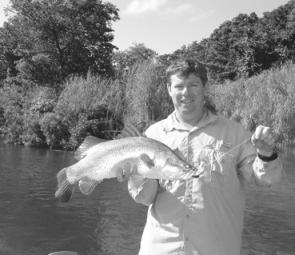Finding fish after heavy rain can be a real challenge but there are a few tips that can help anglers stay on the bite, even in the most trying conditions.
A big downpour tends to disperse fish but they will regroup in various locations depending on the species and conditions. Some fish, like barra, will head upstream or out to the headlands, while others head out to sea to get away from the fresh water and silt.
One of the easiest species to locate after heavy rain is not piscatorial but a scrumptious crustacean – the good old muddie. In major flooding they will head east, but generally there are plenty to be found around the river mouths and on the flats immediately adjacent to estuary mouths. They will spread a fair way from the mouth, so don’t be afraid to set pots or dillies some kilometres from the mouths of major systems. Dillies are your best bet, as they can be checked quickly (no longer than every half hour) as the crabs are on the move and can cover a surprising amount of territory in a tide.
The best place to start your fishy search is at the colour changes. Depending on the amount of flooding and time of tide there will be a quite distinct colour change between the clear sea water and flood water. Fishing the junction, with more attention placed on fishing the clear water, will often bring results. On a rising tide, fish will come back into a system with the clear water and generally stay in the cleaner water. The more predatory species will work the colour change, moving from clear to dirty water, using it for camouflage, so right on the junction can also be a very productive area.
Another colour change worth investigation in barra country is in the freshwater, where two streams meet. If the main stream is clear and a tributary dirty, or vice versa, this is a great ambush spot for barra. Working the colour change, with lures or live bait, from the junction downstream for 20 to 30 metres as the two waters combine is a prime barra location. Barra will also move up into a dirty drain or stream looking for a feed, so also work up the side creek at least a full casting distance from the junction.
Any structure around an estuary mouth can hold a concentration of fish displaced by the fresh, so look for rocks and snags near the mouth. This can sometimes be a single stick or rock, so don’t ignore even the smallest structure, especially if it is sitting out on its own on a sand or mud bank.
Fish will also move offshore to the nearest patch of reef, so these are also worth investigating. Species like barra will often move to the nearest headlands along the coast from an estuary system and these can be highly productive during the wet.
Because the water is dirtier than usual many fish will feed in much shallower water than normal, as they feel safe. Look for any shallow areas that have bait movement, as you can be sure that if there is bait around, the bigger predators won’t be far away.
The main strategy when looking for fish in the floods is to keep moving. Try a spot for 15 minutes to half an hour and if unsuccessful, move on. For ease of movement and the ability to quickly cover a wide area around a boat, I prefer to use lures rather than bait during a fresh. Even if fish are present according to your sounder, but not feeding, it often pays to keep moving and come back later. The problem is the normal cycles of tide change and bite times based on the moon go out the window during a fresh, so sitting on a good location waiting for the fish to come on the bite is even more hit and miss than normal – and that’s challenging enough!
Reads: 1640
This barra was taken by the author, using a SWIK soft plastic, in a milky coloured creek mouth on the Mulgrave River, after a late winter downpour.




